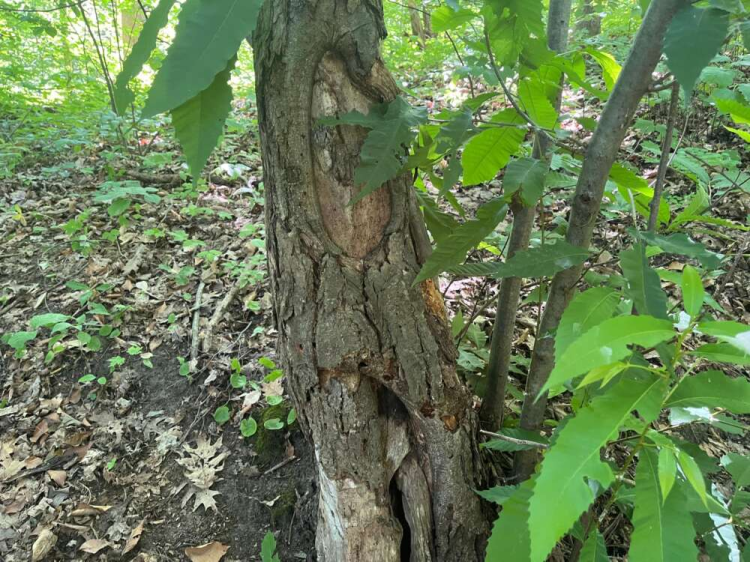Deep in the woods of southern Ontario, University of Guelph researchers are searching for trees that are frozen in time.
Undergrad students Caitlin Barton and Katerina Trieselmann have spent the summer between third and fourth year in the field, tracking, tagging and photographing the nearly extinct American chestnut tree.

The chestnut blight leaves trees with massive wounds or cankers
The American chestnut tree used to make up 70% of the canopy of forests of southern Ontario, along with parts of the United States. But, after a devastating fungus invaded in the early 1900s, there aren't many of these trees left.
In fact, the species will likely be gone within 150 years without successful intervention.
"It's very intense, but it's very cool," says Trieselmann. "We drive to different locations, follow GPS points and a few notes from 10 years ago, and let that guide us to find the trees."
The fungus causes a disease dubbed chestnut blight that leaves the trees with massive wounds or cankers. The blight cuts off the tree's circulatory system, preventing movement of water or nutrients and killing most of the trees it infects.
An estimated 2 million chestnut trees once grew in southern Ontario. Today, less than 1% of that total remains and most are unhealthy and non-reproductive.
The research team is monitoring tree health with the goal of helping the species recover, preventing extinction.
Tracking tree health over decades
This research project to track how surviving American chestnuts are faring began more than 20 years ago under the guidance of Dr. Brian Husband, a professor in the Department of Integrative Biology. The first survey was done in 2001-2002 and repeated in 2014-2015.
"The first survey was an eye-opener as we saw the poor health of the trees dealing with the blight," Husband says. "Following it up has allowed us to further track the disease and get some sense of change from one survey to the next, while projecting the future state of the population."
Now, in 2025, Barton and Trieselmann are checking to see how many trees have survived the last two decades, finding out if the population continues to decline and at what rate.
Trieselmann is pursuing a Bachelor of Science in Environmental Biology with a minor in One Health, while Barton is heading into her fourth year of a Bachelor of Science in Zoology. This work has them actively gaining field experience in conservation science.
"Conservation is a big interest for both of us and getting the chance to do anything in the field is great," Barton says.
Trieselmann adds it's been rewarding to contribute to a large issue while still in school.
"This whole project has been an amazing experience and really fulfilling," she says.
In addition to documenting the condition of surviving trees and looking for new growth, this year's survey is exploring what causes some trees to survive when so many others have died.
"There's a handful of trees that have survived long enough to reproduce," Husband explains. "There are isolated trees that are relatively healthy; they don't have the sunken, expanding cankers developing on the trunk of the tree."
Husband notes they're still exploring if tolerance to the fungus is promoted by a tree's environment or if there are genetic variants that are more resistant to disease. Another possible explanation is the presence of a hypovirus, a family of viruses that infect fungi and could be preventing chestnut blight from spreading.
"The hypovirus reduces the virulence of the fungus, so it wouldn't be able to impact the tree," he says.
Trieselmann says they're sampling trees out in the wilderness for the presence of the hypovirus, particularly trees that aren't suffering as many ill effects from the fungus.
"They might have a weakened version of the blight and that could help with recovery efforts," she explains.
Exploring conservation through hands-on learning
Katerina Trieselmann and Caitlin Barton are U of G undergrad students working on a survey of American chestnut trees
Working out in the field has given Barton and Trieselmann a deeper hands-on understanding of conservation science.
"There are so many people and projects committed to saving trees," Barton says. "Conservation is a huge topic in our world right now with climate change and global warming, and I've always wanted to be part of the solution."
By learning more about chestnut trees and sharing their findings, the students hope to make people more aware of environmental issues and their role in protecting rare tree species.
"It's a very niche area of research, but it's important for people to understand what's at stake," Trieselmann says. "People may have a chestnut tree on their property and cut it down without knowing it's a protected species. We want to spread the word that this is important."
This work was enabled through the support of the Canadian Chestnut Council.













